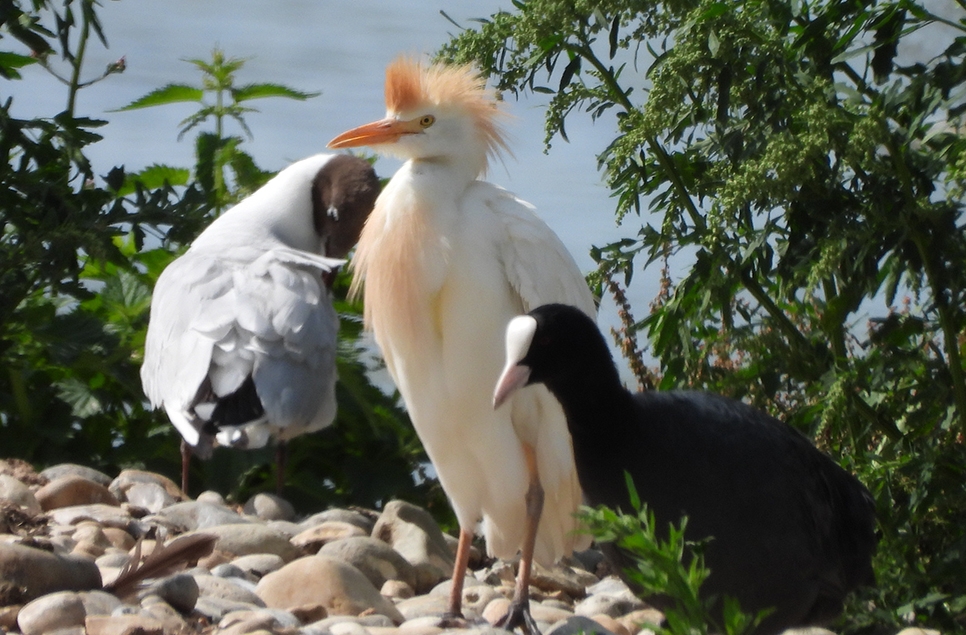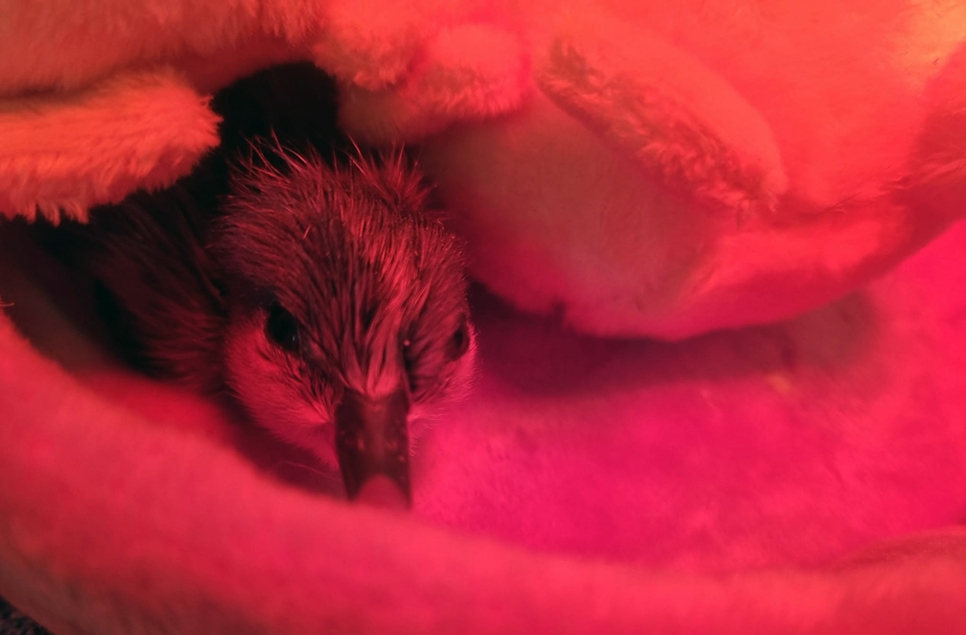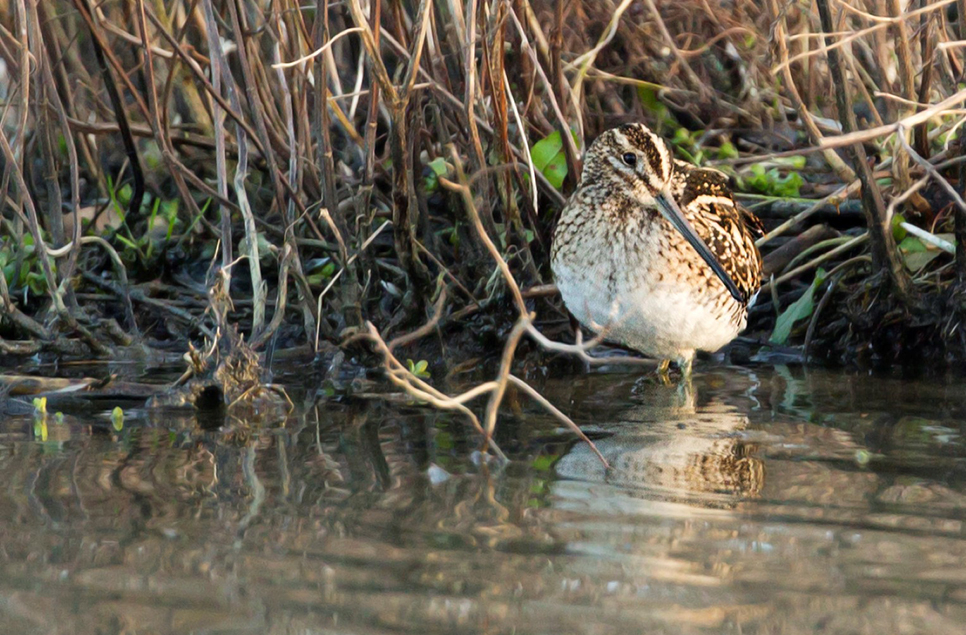Amazing August wildflowers
This riot of colour is bloomin' marvellous this month.
Each summer the meadows and pathways at WWT Arundel Wetland centre explode with a riot of colour, peaking in August.
Wetland wildflowers blooms provide bees, butterflies and other pollinators with food while their root systems extend deep into the soil, storing water and nutrients while holding on to carbon that would otherwise be released into the air.
A huge variety of wetland plant flower at WWT Arundel each summer - in every colour on the palette. As well as being beautiful many were used traditionally as food, medicine or around the medieval home.
Yellows: fleabane, tansy, ragwort
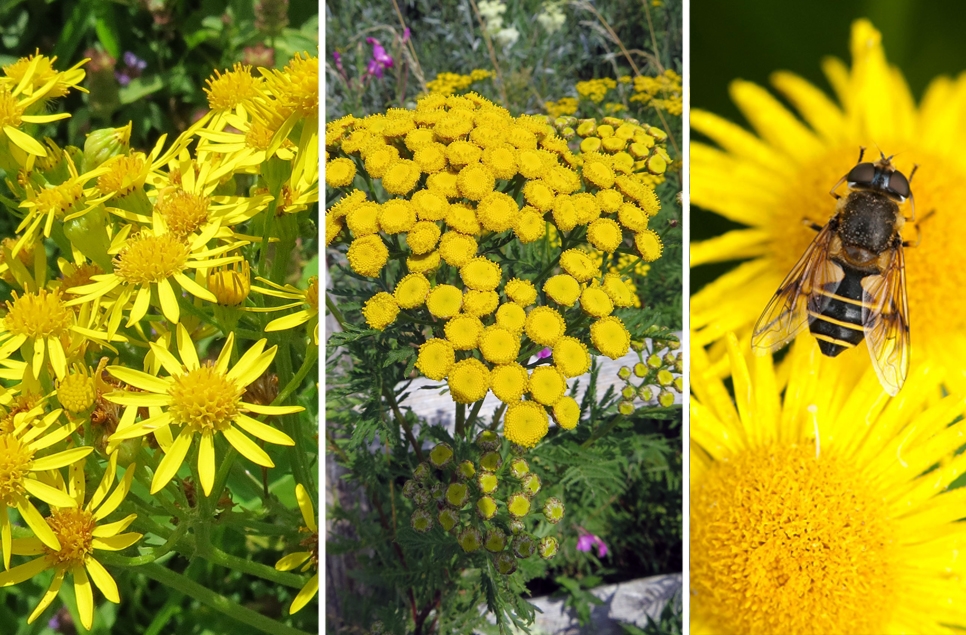 Ragwort, tansy and fleabane flowers
Ragwort, tansy and fleabane flowers
Ragwort’s ragged looking yellow flowers are a source of nectar and pollen to 150 insect species. It has a bad reputation because the plant is poisonous to grazing animals. Cattle and horses avoid eating fresh ragwort but the danger comes if the dried plants end up in their hay. The yellow and black caterpillars of the cinnabar moth enjoy munching away the leaves, absorbing ragwort’s toxic chemical defence so they become nasty tasting to the birds.
The tight heads of Tansy flower in large clusters on tall plants along the paths and in the meadows in August. Tansy can often be found in herb gardens, as it was traditionally used to flavour eggs. The name ‘tansy’ comes from the old word for an herb-flavoured omelette! For centuries, tansy tea was prescribed by herbalists to expel worms because it is highly toxic to internal parasites. In the veg garden, it is said to drive off potato beetles while attracting bees.
Fleabane is a tall plant with large 30mm flowerheads with an even, yellow fringe. They are a type of daisy and the blooms peak mid-August. Traditionally fleabane’s leaves were dried and burned to give off a vapour to drive fleas and other insects away. English herbalist Nicholas Culpeper mentions its use as an insecticide in the 17 th Century. It was also used as a medicine against dysentery.
Pinks: willow herb, hemp agrimony
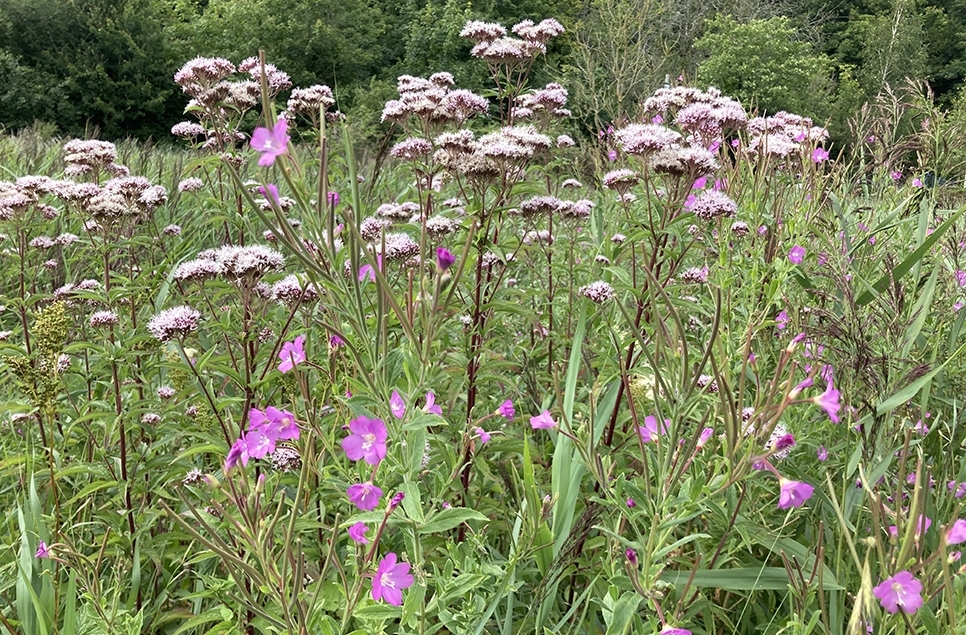
Greater willowherb plants can grow to 6 feet tall. This all plant produces pink flowers in July·and August along pond edges and i-n ditches. Its Latin name means shaggy or hairy. It has hairy leaves; a hairy stem and has hairy seeds that ore blown about by the wind! Its flowers are bright pink with creamy white centres. Rosebay willowherb has bright pink flowers grow from a tall spike. Both willowherbs are food plants for elephant hawkmoth caterpillars.
Hemp Agrimony has dense clusters of small, fluffy, pink flower heads are arranged in pairs on reddish stems. They flower July through September in damp or dry spots, in sun or ·in shade. This plant is food for many insects including red admiral butterflies and small tortoiseshell butterflies. Hemp Agrimony was described as a ‘rough medicine’, due to the violent effects of the herb. In traditional medicine it was used as a purge and an emetic.
Purples: loosestrife, hedge woundwort, self heal
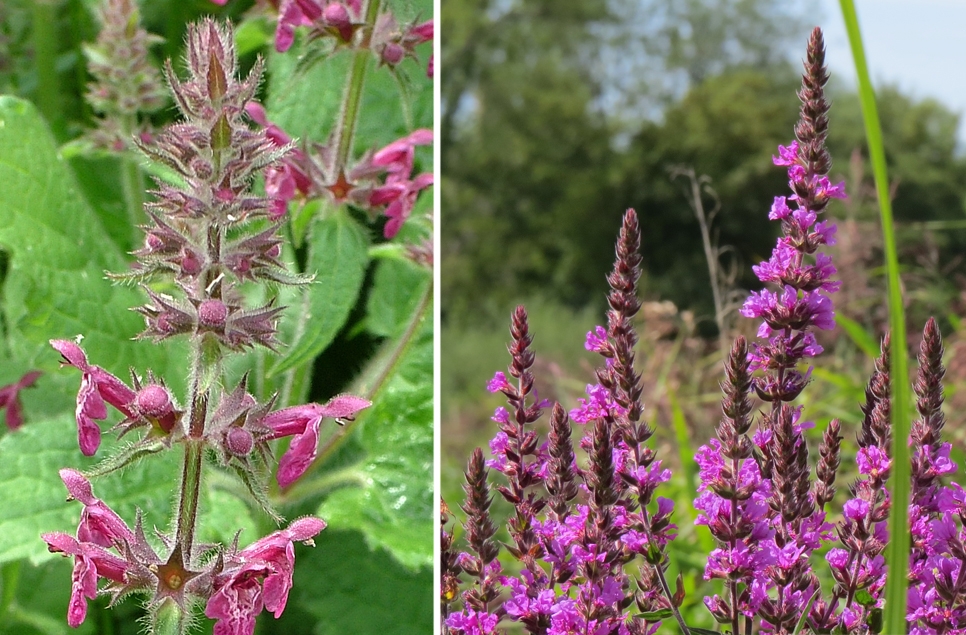
Marsh woundwort was used by the ancient Greeks to stem bleeding and treat wounds. Ointments, poultices and infusions were made from leaves for scrapes. Herbalists use a tea made from its leaves to treat boost the immune system to treat hay fever. It is said to promote calm and help with sleep. Hedge woundwort is popular with pollinating insects.
Purple Loosestrife is naturally high in tannin and was once used for tanning leather as an alternate to oak bark. Still popular in European folk medicine as a wound herb. Purple loosestrife attracts butterflies such as the peacock and small tortoiseshell. It is non-toxic and was traditionally used for the control of dysentery, diarrhoea and fevers. Butterflies love nectar-rich purple loosestrife spikes, especially commas and small tortoiseshells.
With self-heal the clue is in the name. Medieval farmers using sickles and bill hooks and traditional herbalists believed them to help stop bleeding, although this has no scientific basis. Known as Prunella vulgaris this plant is part of the mint family. Its nectar-rich flowers attract bees and butterflies.
Blues: Tufted vetch, water mint and knapweed
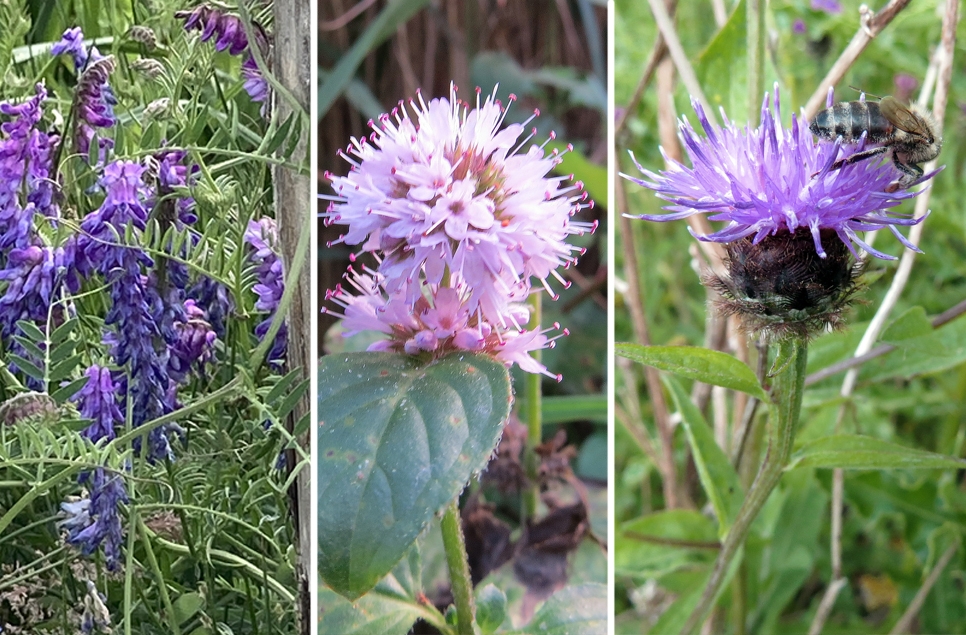
Vetches are in the pea family and use their tendrils to scramble up other plants and fences. Covered with blue flowers its seed pods turn black when they’re ripe. It’s much-loved by bumble bees, butterflies and moths and is an important food plant for breeding butterflies. WWT Arundel has of few types of vetch on site.
Water mint is a favourite of Small Tortoiseshell, Peacock and Comma butterflies. You will spot on the water's edge and it in the reedbeds as it can grow in the water and in very damp conditions. It is an edible plant - the leaves can be used used for mint tea. Traditionally is was used as an early form of smelling salts and to treat stomach upsets and earache. Water mint is believed to have been cultivated by the Romans 2,000 years ago.
There is loads of common knapweed in the meadow that surrounds the path on the way to the Coastal Creek aviary. The flowers resemble thistle heads but the plant is not prickly at all. It flowers from July through September/ Bees and butterflies like common blues and meadow browns love these flowers.
Whites: meadowsweet, wild carrot and other umbellifers
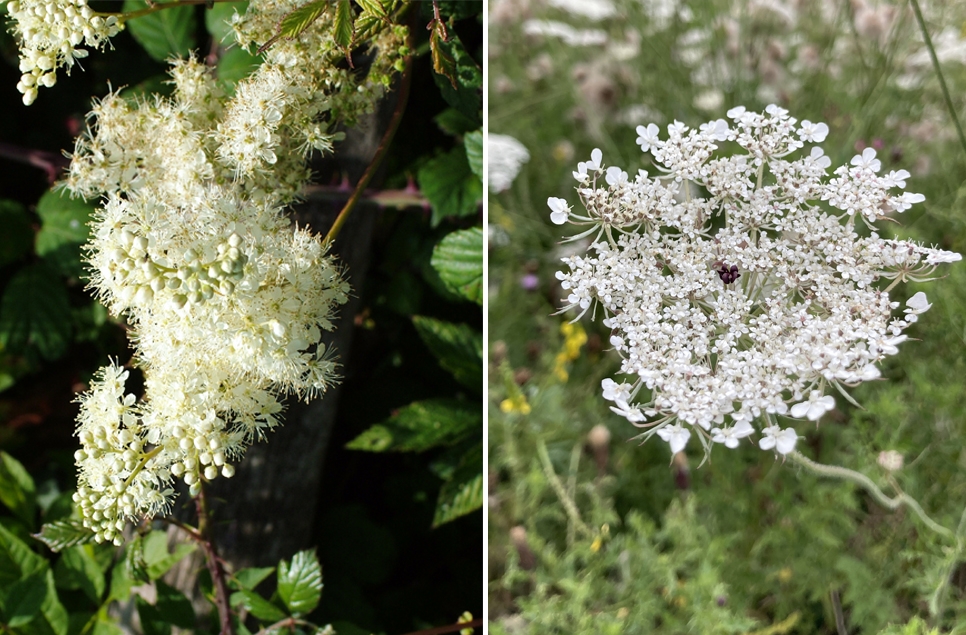
Meadowsweet was held sacred by druids along with vervain and watermint. In the early middle ages this flower was strewn on floors to freshen-the air, giving off a sweet smell when it was trodden on. The flowers smell similar to vanilla.· In traditional herbalism it was used to treat influenza, gout, and body aches. Traditionally a tea of meadowsweet was thought to help kidneys, diarrhoea and sore eyes.
Wild carrot or Daucus carota was used as a 16th century remedy for the falling disease “epilepsy”. An application of the leaves, with honey, cleansed running sores and ulcers. It is rich in vitamins and carotene from which the body manufactures vitamin A. Soldier beetles love it! The flower head unfurls as flowerets from a cup shape and is all white with one dark red floweret in the centre.
To be honest we even have trouble telling all the umbellifers apart! There is variety of sizes and species onsite. The flower 'umbels' that make the plants distinct come in a variety of hues of white. You may see cow parsley ground elder and hemlock along with hogweed. , Hogweed can grow a high as two metres. The stems are thick with coarse hairs. Giant hogweed is even taller and its stalks are streaked with purple - avoid this plant as the sap makes skin photosensitive and causes skin blistering.
Green: nettles and phragmites
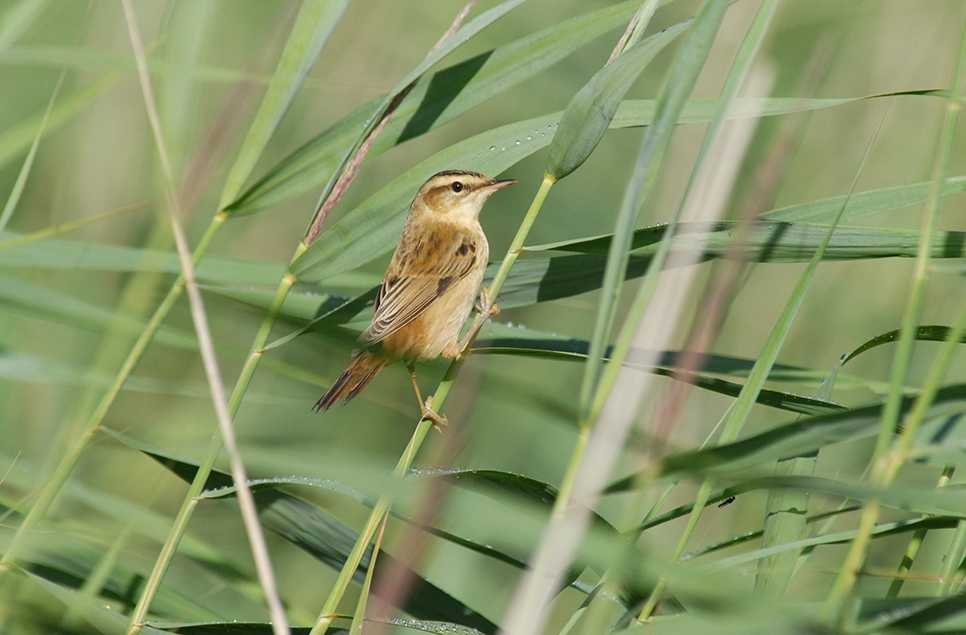
Nettles are going to seed in august. Rich in vitamins and minerals the seed can be collected and sprinkled over foods as a nutrition boost. Nettle cann be used in salads, as a boiled vegetable or as a herbal tea. Fibres from the stems can be made into rope, cloth and paper. Traditionally it has had many uses as medicinal and cosmetic preparations, for wheezing, worms and hair loss.
Phragmites australis is common reed makes up most of our reedbeds. Its a member of the grass family and can grow 3 meters high! Its roots filter reedbed water while its stalks and leaves provide shelter and nesting habit to warblers and dragonflies and marsh harriers. The leaves turn brown in autumn and make up the reedbed whisper heard when the winds blow in autumn and winter.
